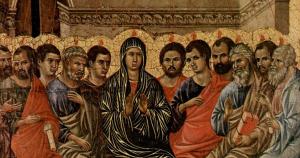To continue the series on ways of deepening our relationship with the Holy Spirit, I have been doing quite a bit of research into charismatic renewal and prayer groups over the past couple of months. One thing I discovered is how fraught with negative connotations that word “charismatic” is for many people. For some, their experiences with “charismatics” conjures up word associations such as “crazy,” “hucksters,” “cultish,” and even “abusive.” And they have gut-wrenching true stories that make those associations completely understandable and valid.

Yet other people I talked with testified about how charismatic communities saved and transformed their faith and their lives. Two people I talked with, in particular, each found the strength to take care of profoundly disabled family members, and also discovered spiritual gifts that they are now able to share with others. One is a middle-aged Latino man, the other an older white woman, from different parts of the country, speaking different languages in their prayer groups, yet their uplifting stories of their engagement with the charismatic movement are remarkably similar in tone and effect.
Still others associate “charismatic” primarily with praise-and-worship style music. One priest said to me “that’s not my style personally, but I see there is a place for it and should be available to people.” Another friend said she missed the charismatic-style music and other liturgical practices of her childhood parish. In this understanding, “charismatic” is more a aesthetic style than a distinct spiritual path, making its value personal and morally neutral.
What I want to discuss here is the second form of charismatic experience: a positive and powerful means of increasing God’s life within us, through regular participation in group prayer and fellowship with other Christians who are seeking the Spirit. But I don’t want my readers to get hung up on the word “charismatic” based on association with negative experiences or worship style preferences. So from here on I’m going to try to dodge preconceived notions by using a neologism: a Third Way of Prayer.
Why a Third Way of Prayer?
As I was researching this topic, I discovered that the Vatican is actually launching a new “public juridical personality,” called CHARIS, to nurture the communion of charismatic communities, give leaders ongoing formation, and to impart the Church’s official “teaching in relation to, and in service of, Catholic charismatic renewal.” First announced by Pope Francis at a Pentecost Vigil celebration of the 50th anniversary of the beginning of the Catholic charismatic renewal movement, CHARIS will officially come into being on Pentecost 2019 (June 9th), and replace the International Catholic Charismatic Renewal Service and the Catholic Fraternity of Charismatic Covenant Communities and Fellowships at that time. In preparation for this new creation, Fr. Raniero Cantalamessa, OFM Cap., longtime preacher to the papal household and appointed Ecclesiastical Assistant to CHARIS, has started providing monthly meditations about this work and movement. His first meditation, for March 2019, is the basis for my calling this the Third Way of Prayer:
In the Charismatic Renewal, prayer manifests itself in a new form compared to the past: that of [group prayer]…. We only know two basic types of prayer: liturgical prayer and private prayer. Liturgical prayer is a communal one, but it is not spontaneous; private prayer is spontaneous but is not communal. We need moments in which we can pray spontaneously, as the Spirit dictates, but sharing our own prayer with others, putting together the various gifts and charisms and enriching each other with our fervor; putting together the different ‘tongues of fire’ to form a single flame. In short, we need a prayer that is both spontaneous and communal.
I also see a correspondence here between different forms of prayer and the Persons of the Trinity. Private prayer draws us closer to Our Father, who has given us the spirit of adoption, prompting us to call out as His unique children with our petitions and praise. (I would also add to this the private prayers imploring the intercession of Our Mother, Mary and all the Communion of Saints, who give us examples and encouragement in our personal formation as children of God growing into maturity.) Liturgical prayer draws us closer to the Second Person of the Trinity, Jesus Christ, God Incarnate, made present in the Word and the Eucharist and the assembled Body of Christ. But where is the prayer that draws us closer to the Third Person of the Trinity, the type of prayer that calls down and coordinates the gifts (charisms) of the Holy Spirit that we see powerfully at work in the pages of the New Testament, but more rarely in our Christian communities today?
Father Cantalamessa says we need a prayer that is both spontaneous and communal. We need a third way of prayer that melds attributes of the other two, and yet is its own “person.” In order to pray to and in the Holy Spirit, we need the opportunity for two or three to gather that the Spirit may be in our midst, praying not as individuals side by side, nor at the direction of a priest acting in persona Christi, but as the Spirit moves among those gathered, revealing to us how we as unique persons can come together to fruitfully become more than the sum of our parts.
This Third Way of Prayer may seem awkward, strange, even dangerous to the uninitiated. This is how intercourse always is. Because it is neither individual nor formulaic, we do not know what to expect, and the outcome is beyond any one person’s control. But I wouldn’t call this a “new form compared to the past.” It is a form as old as humankind, though every occurrence is something new. This form of prayer clearly was practiced by the early Church, and throughout the ages among various religious orders and communities. This type of prayer is how the Church grows in size and fruitfulness. If it seems “new” because it has largely been forgotten in our cultural memory, then that well explains why the practice of Christianity is shrinking in much of the world today.












